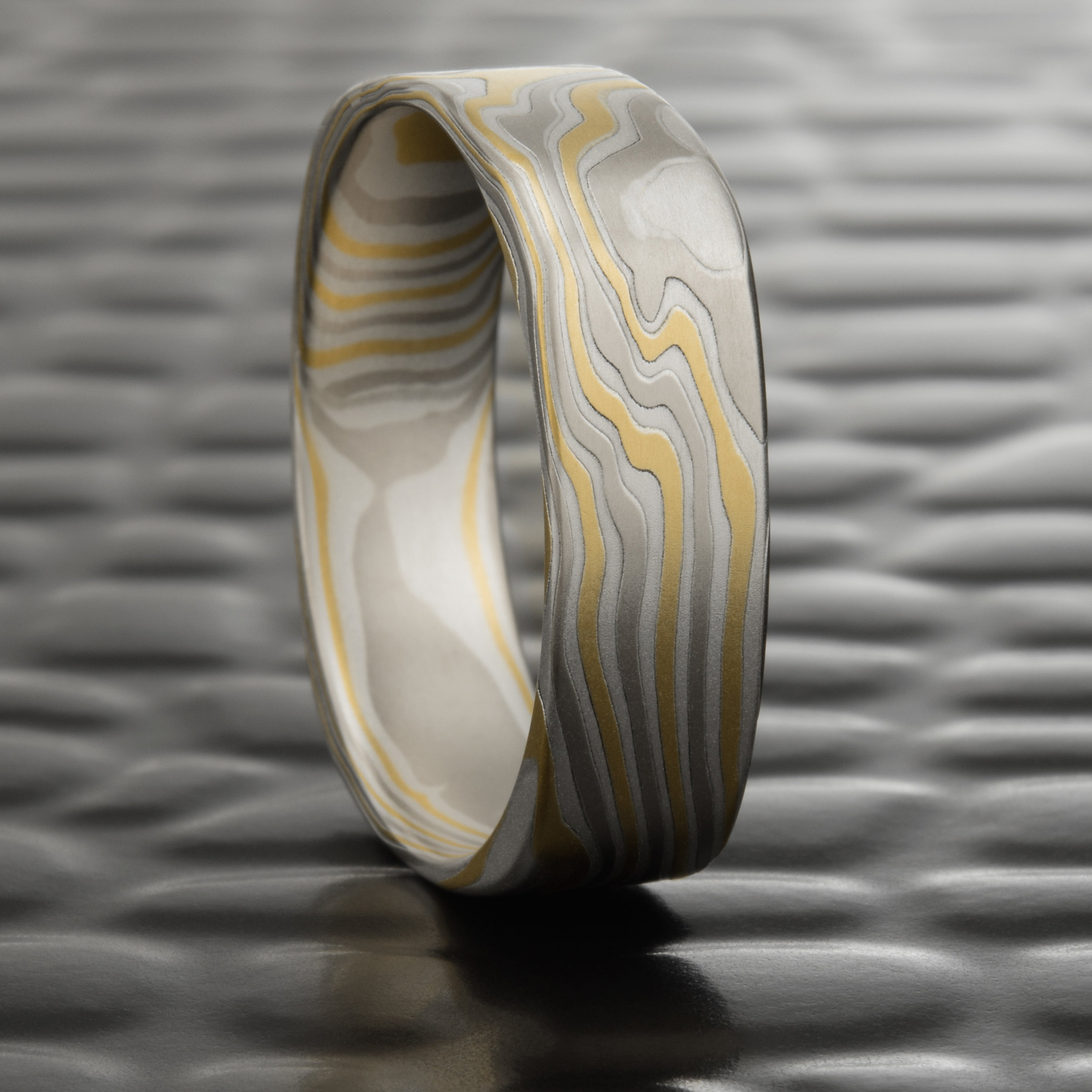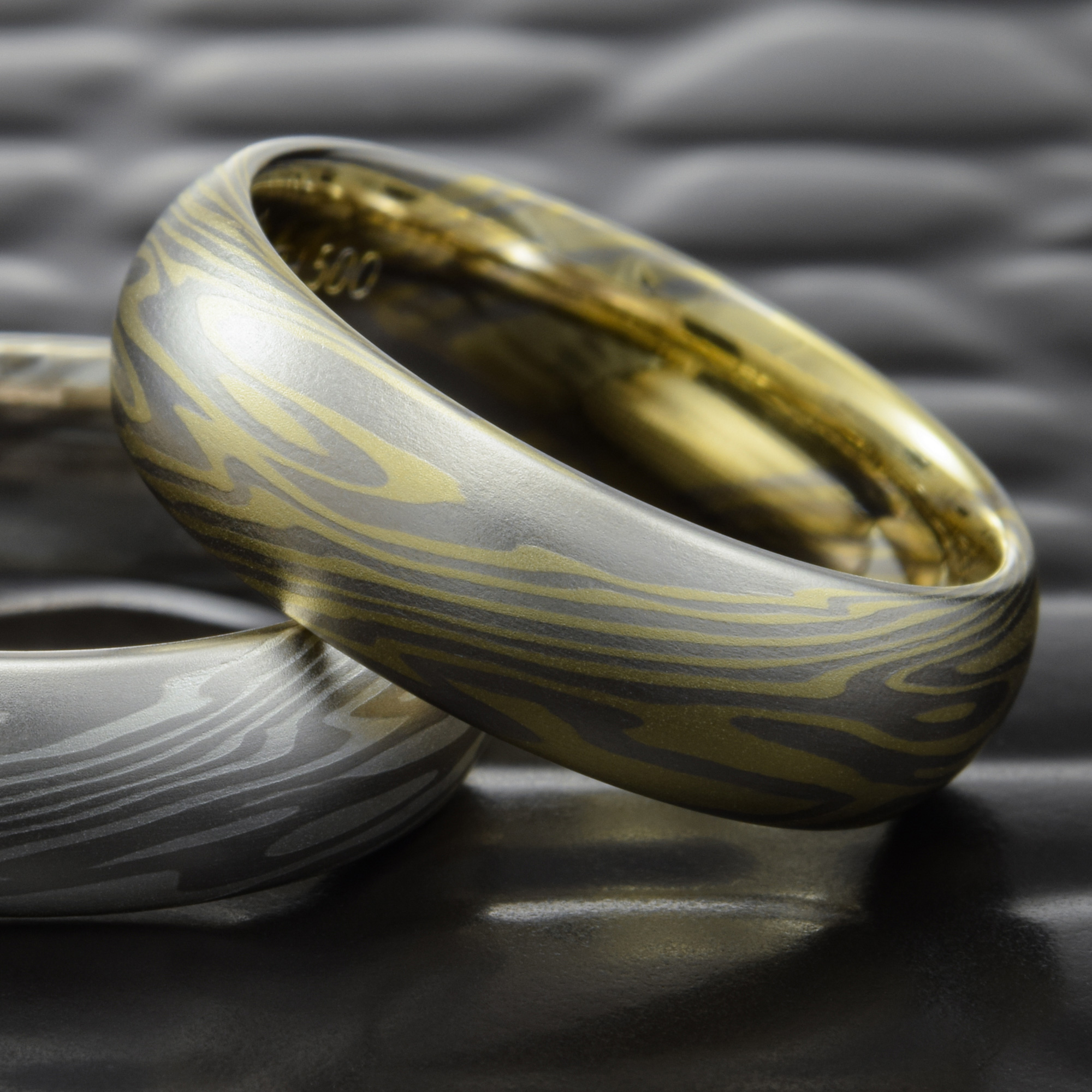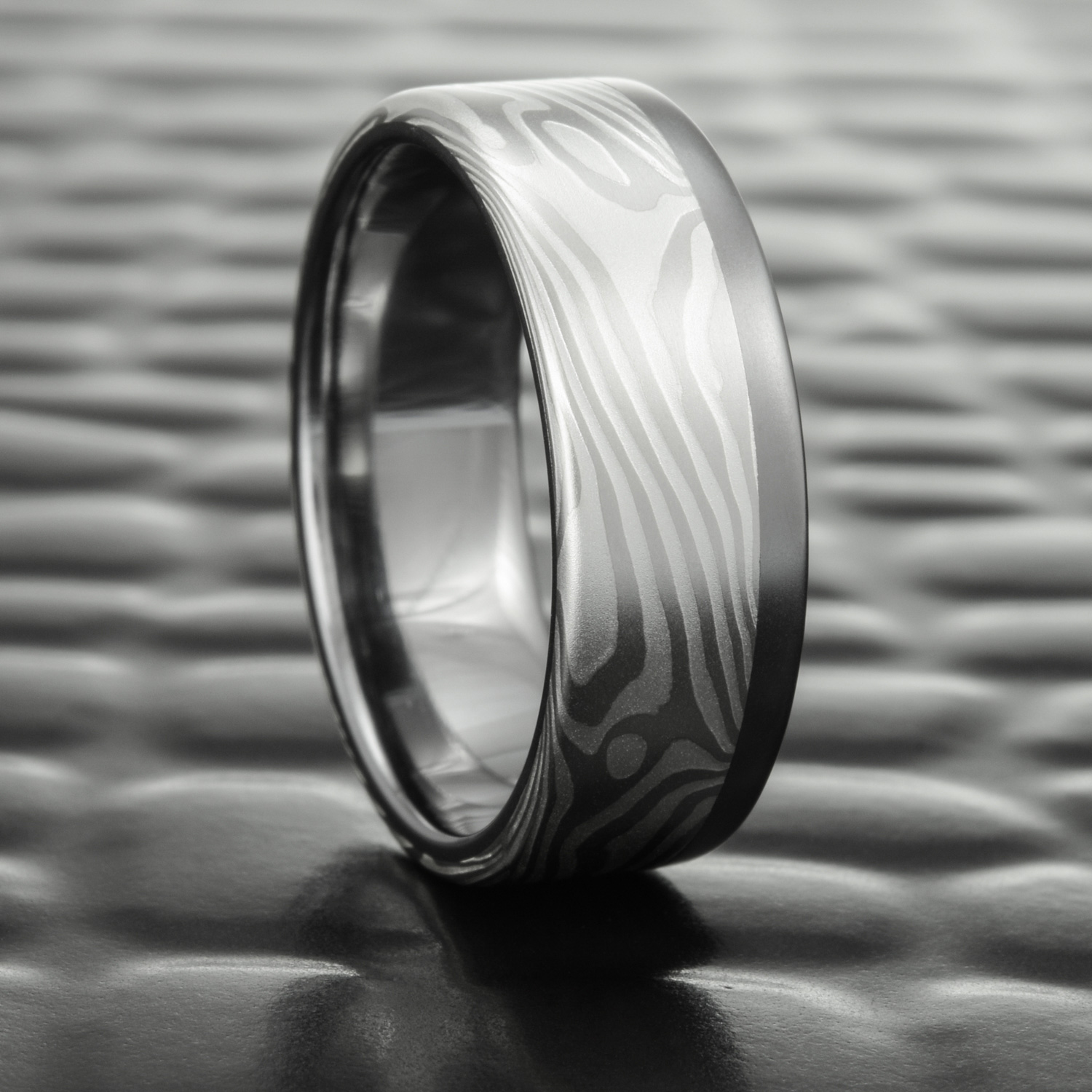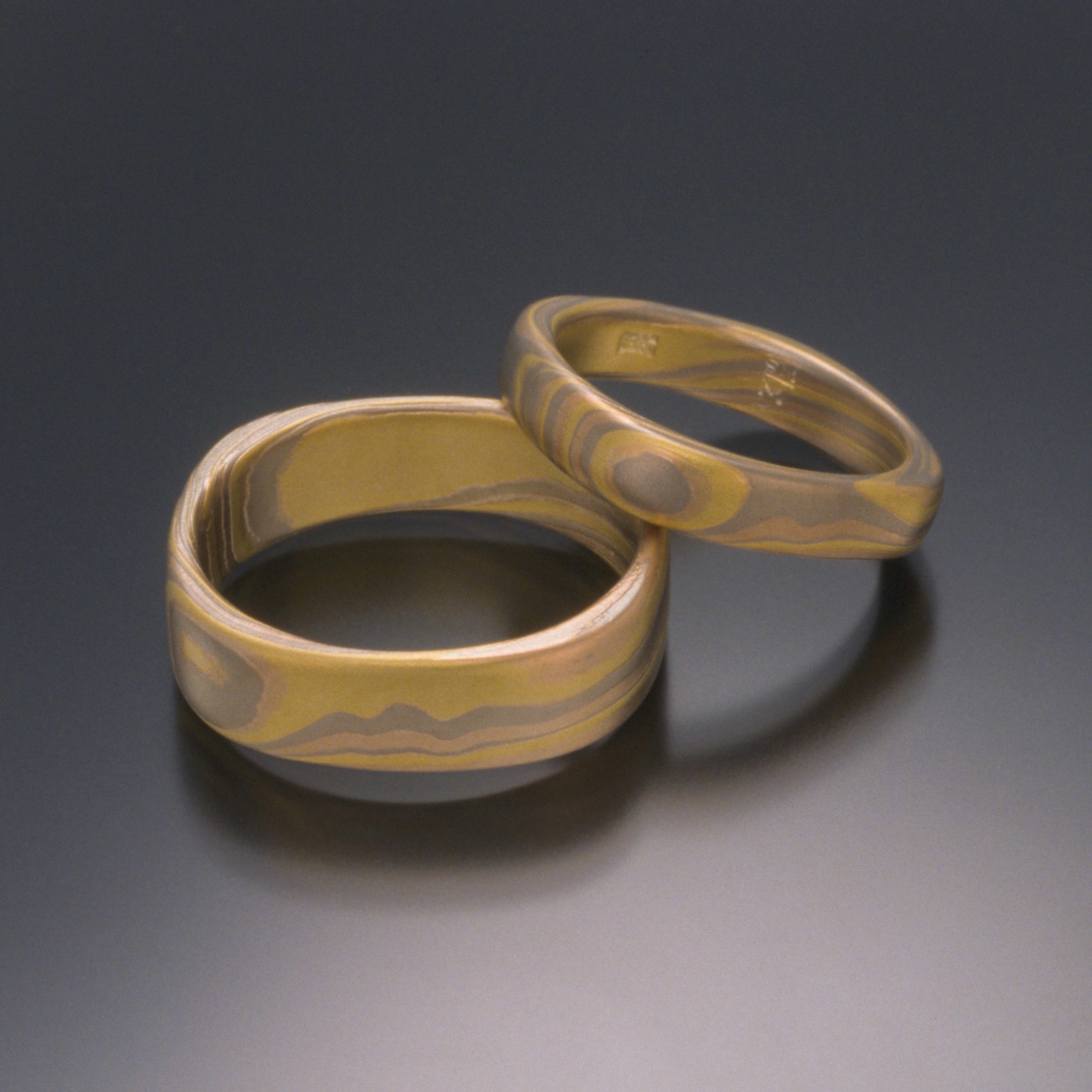Metallurgical Theory for Mokume Gane
Understanding the way metals behave in a mokume billet
“World Gate” by James Binnion. Sterling silver, copper, and brass. Photo: Bob Barrett.
“The diffusion area in mokume is much less than one-thousandth of an inch … it is the growth of new crystals at the point of contact between the sheets that bonds them together.”
Metallurgy for Jewelers, Knifemakers and Metalsmiths
First off, let’s get something straight. Neither of us are metallurgists. I know I’m not, and if you were, you probably wouldn’t be reading this book. But, hey, guess what? That doesn’t mean we can’t understand the basic metallurgical principles that are at work here. Come to think of it, our brains (and our shirt pockets) are probably much less cluttered than most metallurgists, which may give us an advantage.
Let’s begin this discussion with a statement about what comprises the optimum bond between layers of metal in a mokume billet.
The layers of a mokume billet should be completely and permanently bonded into a single unit, while retaining very clearly defined color boundaries. Any third alloy formed during the bonding process from the parent metals, should be kept to an absolute minimum, so as not to blur or muddy the demarcation between the metal layers.
It sounds simple enough, but what we are talking about here is a very delicate balancing act. Balanced on the one hand, is the risk of under-firing a billet and having it delaminate during patterning because of immature welds. On the other hand is the risk of over-firing the billet and going beyond the welding stage to the point where the metals diffuse, or melt together, to form a new homogeneous alloy with little or no definition to the individual layers. To help you comprehend this critical issue, it is important to have an understanding of the metallurgical principal of diffusion bonding which you will be using to weld mokume. Thorough knowledge of this information can help you understand what’s happening to your billets and greatly increase your chances of success. It will also help you impress your friends and colleagues.
Diffusion Bonding
“Hair Ornament No. 1” by Hiroko Sato Pijanowski and Eugene Pijanowski. Shakudo and fine silver.
To fully understand how multiple layers of metal in a billet of mokume weld together to become one, it is necessary to have a practical understanding of what diffusion is, and at what point in the process it becomes eutectic or fusion bonding. There are three important conditions, that contribute greatly to the successful welding of two or more pieces of metal together for mokume gane.
They are:
1. The surfaces of the adjoining metals must be clean and free of contaminants or oxides.
2. The surfaces of the metals must be held under pressure and within close proximity of each other.
3. The metals must be held in this position a sufficient amount of time (relative to their temperature) to allow complete bonding by diffusion to occur.
Let us look at these conditions a little closer, and use the following illustrations to depict what is happening on a very small scale in the weld zone of two pieces of metal. Practically speaking, it is impossible to get a piece of metal absolutely clean. Surface dirt and oil can be scrubbed away, along with heavy surface oxides, but it takes only a matter of minutes for new oxides to begin to form. By cleaning, what we are trying to achieve is the thinnest possible layer of oxides and other contaminants on the surface of the metal. The thinner this layer is, the more easily the forces of plastic deformation and flow disrupt this layer when the two pieces of metal are pressed together. Also, the more easily the atoms from one metal can diffuse into another.
Figure 1 shows the two metals pressed together in the beginning stages of diffusion bonding. The metals initially touch at just a few, small points due to asperities (roughness) on the surface of the metal. It is at these points that the forces of plastic deformation break through the oxide layer, enabling diffusion to begin.
Figure 1.
Over time, and as the metal reaches a higher temperature (or pressure), more plastic flow takes place, which, in turn, brings a larger surface area into contact (Figure 2).
Figure 2.
All the while, diffusion continues to take place. This happens not only by the movement of atoms from one metal to another, but also by the oxides and other contaminants which have formed into small pockets in the weld zone (Figure 3).
Figure 3.
As the weld matures, new crystal grains of a third alloy begin to form from the combination of the two parent metals that have diffused into one another. These grains grow across the original grain boundaries that once defined the surfaces of the metals and bonds them together. Continued diffusion diminishes the size and number of contamination pockets by the diffusion of oxygen away from the oxide particles, thus reducing these to parent metal (Figure 4).
Figure 4.
Mokume Earrings by James Binnion. Silver, copper, and brass. Photo: George Post.
This process is greatly influenced by the temperature of the metals being bonded. By increasing the temperature, and thereby the movement of the atoms in the metals, we significantly decrease the amount of time it takes to complete a weld to that of a few hours. The creation of mokume utilizing this kind of welding process requires careful temperature and atmospheric control, as well as knowledge of the proper bonding time and temperatures for specific alloys used in the billet. Setup costs for this type of bonding operation are higher than the others discussed in this book, but the clearly-defined color boundaries that can be achieved by this method makes the investment worthwhile.
What I have described up until this point, is known to metallurgists as Solid State Diffusion Bonding, and is the process that is employed in long-duration electric kiln-firing which is described by James Binnion in Chapter VII (Firing Methods). Robert Coogan and I (also in Chapter VII) explain other bonding methods that more closely resemble the process that has been used by Japanese metal workers for hundreds of years. Joint bonds by these methods are achieved by what is called Liquid Phase Diffusion Bonding.
Let’s go back to the illustrations. In Liquid Phase Diffusion Bonding, stages 1 through 4 are basically the same as in Solid State Diffusion Bonding, except that there is less time for the weld to mature due to the shorter firing cycle. Figure 5 shows the weld zone once it has reached the melting point of one of the metals present. This could be one of the parent metals but more likely, it will be the eutectic alloy formed where the parent metals touch as it reaches its liquid-phase eutectic point.
This liquid metal becomes filler material and easily flows to fill the remaining voids between the layers (Figure 5).
Figure 5.
It also aids in the absorption and dispersal of contaminants in the weld zone. It is this metal that we detect as “sweating” between two sheets in a mokume billet, and is what, when solid, bonds the layers together. Not all metal combinations form eutectics. If bonding by this process is desired, it may be necessary to introduce another metal in the form of a thin interlayer which will create the eutectic alloy.
Two of the advantages to this kind of welding procedure are the fact that it can be done in about a half-hour, and that the critical liquid phase eutectic point may be observed. This type of bonding requires very little in the way of special equipment, but it does rely heavily on your own observations. When using this welding method, it is important to achieve the thinnest possible alloy layer that will permanently bond the metals together. The judgments you make, based on your observations, will to a large degree, determine the quality of your mokume. Until you gain enough experience in firing billets by this method, you will always run the risk of over-firing them, as shown by the 18K and shakudo billet at left. In Chapter VII (Firing Methods), I list a number of signs to look for when using Liquid Phase Diffusion Bonding methods. Use these to help you recognize when the metals have welded. For a further discussion of the principles of diffusion bonding and how they relate to electric kiln-fired mokume, see James Binnion’s excellent article in Chapter VII.
Metal Compatibility
Platinum and 18K diamond wedding rings by Steve Midgett.
Aside from using poor quality sheet stock, one of the biggest problems you can have when producing mokume is metal incompatibility.
It’s the same thing as fixing two friends up for a blind date. You could arrange (you devil, you!) to get your biker roommate to go out with the interesting person you met at the Thirty-Something Lawn Darts Club, but unless they have enough things in common and are compatible, nothing you do will keep them together. It is the same with mokume. For our purposes, there are three factors that determine whether or not certain metals are compatible. These are hardness, the general working characteristics of the alloys, and the characteristic of the eutectic alloy formed by the combined metals.
Hardness
Using metals with markedly differing hardness will cause problems when you start to roll out the billet. The cause of the problems associated with differing hardness can be traced back to the simple fact that a soft metal requires less pressure to deform or elongate than does a hard one. This means that if equal pressure is applied to both the soft and the hard metals, the softer of the two will show the most deformation or movement.
Let’s say you made a simple two-sheet laminate of pure 24K gold and jewelers palladium. You probably wouldn't use these metals together, but because of their great difference in hardness, they make a good example. The results, upon rolling a sheet like this, would reveal that the 24K side would have compressed, widened, and, most especially, lengthened more than the palladium side. This would cause the laminate to curl in toward the palladium side, which is more rigidly held in its original shape, as is shown in the illustration on the right.
The 24K would also, upon continued rolling, bulge more and more out the ends and sides of the sheet, and this material would eventually have to be trimmed away. Think, for a moment, about what stresses are developing in the center of the sheet. Both pieces of metal have the same amount of pressure on them over the entire area of the sheet. The rollers are transferring the pressure evenly but certain areas of the sheet react differently. Along the edges of the sheet, there is nothing but space, and the metals move freely towards it. Since the 24K is softer than the palladium it moves to a greater degree. The 24K in the center of the sheet, however, is contained by the rest of the 24K surrounding it, as well as by the palladium to which it is bonded. It wants to move as much as it can at the edge of the sheet, but it is held in place. Therefore, it builds up internal stress, which is focused in the weld zone between the two pieces.
“Arrow point II” by Steve Midgett. 14K white gold, shakudo, and 18K yellow gold.
Now, imagine, instead of two layers of metal, you have 12, or 20, and you begin to understand the stresses that can develop in a billet of mokume. Not only can this cause delamination, most likely at the ends and edges, but in some cases, it can actually tear the metal apart.
When a billet containing metals with great differences in hardness, such as the one described above, is elongated by passing it through a rolling mill, the softer metal in the laminate attempts to elongate at a greater rate than the harder metal. As it moves, it tries to pull the harder sheet along with it. This can, in extreme cases, slowly pull the harder sheet apart, usually in a regular pattern, which closely follows the metals’ internal grain boundaries. As this happens, the softer metal then fills in the “cracks.”
Upon examining a cross section of this type of billet, one finds a scaly pattern that is sometimes quite beautiful. Most of the time, however, the billet fails completely. Sometimes the billet will neither fail nor form this beautiful, edge-grain pattern. The condition will develop, but to a lesser degree, and when you develop a pattern in the sheet, the layers will have a ragged appearance. The harder metal’s quality and ductility are also factors in the development of this pattern. The less ductile the piece is (or larger the grain structure within it) the greater chance that this cracking will occur.
General Working Characteristics
These include the metals’ malleability and ductility as well as their rates of work-hardening and the preferred method of quenching. It also encompasses the annealing temperatures. If, for example, you are using platinum in a billet combined with another metal whose melting temperature is below the annealing temperature of the platinum, it will be impossible to anneal the platinum completely after it work hardens. The more similar the metals are in these areas, the easier they will work in a billet. It does not necessarily mean you can’t use differing metals together but, like your roommate and the President of the Lawn Darts Club, life together will always be a struggle.
“Shield Brooch #13” by Ian Ferguson. Copper, titanium, and sterling silver.
Alloy Characteristics
The characteristics of the alloy created by the bonding of two parent metals will also contribute to the laminates’ success or failure. For example, certain concentrations of the copper-silver system create an alloy that is relatively brittle. This, in fact, corresponds quite closely to the eutectic point of copper-silver and can contribute to the billet’s failure. Solid State Diffusion Bonding typically avoids this problem and properly fired Liquid Phase Diffusion Bonding can keep it to an easily-managed minimum. For metals that do not form a eutectic, similarities of hardness and general working characteristics are even more important.
Use the chart at the end of this post as a general guide for the metals you can successfully use for mokume. These, of course, are just some of the possible combinations of the more common alloys. Take the information I’ve given you here, and, with experimentation, you can come up with your own personal combinations and palettes of colors.
Solid State Diffusion Bonding
Solid state diffusion bonding has been developed almost entirely by the aerospace and nuclear energy industries where the weld quality control of high-performance materials is of paramount importance. Ian Ferguson of the Royal Melbourne Institute of Technology in Australia has done extensive research into applying these industrial processes to the manufacture of mokume gane. Dr. Ferguson states:
“The use of modern solid-state diffusion-bonding techniques has been applied to the manufacture of mokume gane. Equipment has been developed and a production methodology established for the solid-state diffusion-bonding of metal laminates. In order to create the desired conditions of pressure, temperature and time, a complex jig to retain the mokume gane metal sheets is installed in a controlled atmosphere furnace attached to a hydraulic ram; this creates a form of ‘hydrostatic pressure’ through the layers.
“Current scientific data, e.g. phase-diagrams, physical and chemical properties of metals are used to establish appropriate bonding conditions for each metal combination. With full control of diffusion parameters, a wide range of metals can be bonded at temperatures below critical-melting or fusion points. For example, large billets of traditional Copper/Silver/Gold alloys have been bonded at 600°C, well below the eutectic/solidus point of 778°C. To date, the process has been used for the successful bonding of 40 different combinations of metals. As many of the combinations have quite disparate mechanical properties, a precise methodology has been developed for the deformation of the bonded billets.”
Dr. Ferguson reports success with unusual combinations of metals, including silver/titanium, copper/nickel, copper/stainless steel, copper/iron, copper/titanium, brass/iron, brass/stainless steel, iron/stainless steel, and nickel/aluminum, among others. His research into finding other combinations of metals suitable for mokume continues.
“The application of modern metallurgical knowledge and practices eliminates the problems of how to bond a billet of laminated metals. The problem shifts to development and exploitation of the bonded metals — how to deform them, how to manipulate them, and how to use them.”
Bowl by Ian Ferguson. Copper, titanium, and sterling silver. Photo: Terence Bogue.
Left: Bowl by Ian Ferguson. Copper, titanium, and sterling silver. Right: Bowl by Ian Ferguson. Fine silver, nickel, and sterling silver. Photo: Terence Bogue.
New Layers — What We’ve Learned Since
More to come!
From the Book’s Gallery
©2000-2019 STEVEN JACOB INC. All rights reserved. Copyrighted materials – no portion to be reproduced without written permission from STEVEN JACOB INC.



































